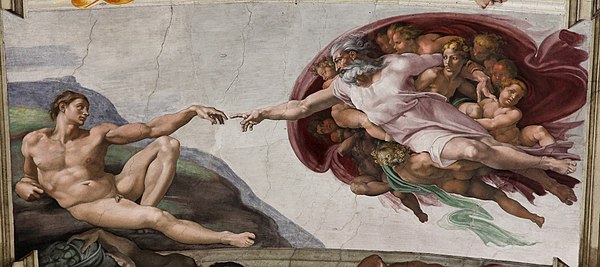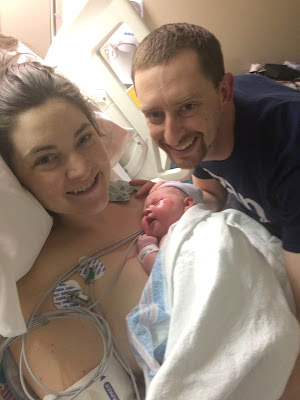by Dan MastertonAt 29, I’ve already worked four jobs. I left my first job to join my then-girlfriend to discern marriage in the same city as well as to accept a full-tuition scholarship for grad school. I left my second job to eliminate a huge commute before I got married so that we could start married life with more time together. I left my third job because our school was condensing and restructuring, and my role was disappearing. And now I’m starting my fourth job.
Some folks at this stage have only worked at one place. I say this not to bemoan my various stops, which have each shaped me in constructive ways. Rather, I find myself struggling to acclimate this time.
After my daughter, Lucy, was born, I was able to take twelve glorious weeks of paternity leave, which were
an even greater blessing than I could have ever imagined. My wife, Katherine, and I decided we’d prefer to avoid day care. Working around Katherine’s three 12-hour nursing shifts, I was able to negotiate my job down to a part-time role at two, sometimes three, days a week. In that equation, we needed no regular child care, and Lucy was with one or both of us all the time.
Professionally, returning to the same school at a scaled-down role was pretty doable. I had all the institutional knowledge and internal relationships to sustain what I was doing, and I managed, with a lot of help from colleagues, to remain fairly present and effective. However, as I start a new part-time job at a
new school on a part-time basis, I find myself frustrated. I have experience, expertise, and education but none of the institutional knowledge and internal relationships. And that latter part is taking me twice as long (if not longer) to develop than if I were full-time.
As I look back over my brief career so far, I can remember moments at each stop that helped me feel like I really belonged, moments that uniquely welcomed me into the community. And these moments give me consolation and reground me in humility and patience as I strive to get up to speed this time around.
Making the PlaylistMy first job was as a half-load theology teacher and assistant campus minister at a Jesuit high school. It was my first chance to be with high school students on campus on a daily basis, and before faculty meetings or school days began, I was invited on a summer service-learning immersion. Along with our Director of Campus Ministry and a Spanish teacher, I co-chaperoned a group of about twenty students on a four-day immersion in East Los Angeles. While the site visits, learning opportunities, and direct service encounters were memorable, it was the drive home that sticks uniquely in my memory.
Driving a ratty old Chevy Tahoe that stuck out like a sore thumb from our fleet of white, logo-wrapped Ford vans, I brought some tired souls back home after an exhausting trip. As we plodded along I-10, one brave soul was awake. She offered some suggestions for radio stations to listen to and as we neared our exit for home, we both gave each other one song to listen to later for homework. After the school year started, this student tracked me down
1 to follow up and suggest another song, a ritual that continued into the year.
As the year unfolded, this student had my counterpart as her teacher for Gospels in Action rather than me. That teacher was a studious theologian, well steeped in the best of Dominican and Thomistic theology. My approach was slightly less academic and leaned more on discussion and engagement. This student took the best of my colleague’s teaching and came to me with her extra questions that didn’t get answered in class; over time, we built a little lunch group with other curious students where we aired out these questions together and tried to engage with the tough stuff of our faith.
Later in the year, I learned she had been baptized Presbyterian but never continued in that tradition and now she was interested in becoming Catholic. I worked with a local parish to get her involved in a Confirmation program that would also prepare her for First Communion. She joined, and though she had the all too usual mediocre experience of parish formation, she remained engaged on campus in class, on retreats, in service, and in conversation. And she honored me with the invitation to be her Confirmation sponsor, even though I had moved away by that point. I flew back to be with her for her big day, and I got to present her to the bishop for Confirmation and come forward behind her for her First Communion. She went on to realize her dream of being a Eucharistic Minister at her baccalaureate Mass. Melissa was the first student to really welcome me to that school, and her impact on me as a person and a minister endures.
Pulling up a ChairNext, I became the first full-time Campus Minister at a medium-sized diocesan high school. Following a chain of part-time ministers who also taught while ministering on the side, I had the chance to try to consolidate what was going on and build it up and out into something more robust and substantial. One of my early goals was to try to create a space that was different from classrooms, which was hard since my space was an old classroom. I remembered so vividly the couches in my high school’s campus ministry. I was dead set on creating that family room feel, despite having the same tile, chalkboards, and fluorescent lighting that all the other archaic classrooms had.
So, I looted a storage area around the corner and dragged a couch and an easy chair into my classroom as well as a few old chairs I could place by my ostentatious desk.
2 I slid my desk up close to the door with the chairs right in front, hoping it’d become a place for students to come check-in about activities and retreats or just stop to relax and say hi.
Over the first days and weeks, I was trying to get myself out there, but the room wasn’t quickly becoming a new home for students. Luckily, I had one more incetive -- my room had air conditioning. Maybe the allure of a cool respite from the steamy hallways would entice visitors...
3It was after our first Kairos meetings began that my first regular visitor started to come by. She was one of our student leaders who would lead our first ever Kairos, and she remembered my name and face from the first meeting. One day, after school, she knocked on the door (shut to keep the air in, but with an inviting sign on the window) to come in, sit down, and say hi. I don’t remember what we talked about, but she kicked back a bit and relaxed. She knew this wasn’t a classroom.
4She would come by most days, even if just to say hi. She never shared anything inappropriate or especially personal; she didn’t come to me for pseudo-therapy. She just was friendly and pleasant, and this became part of her school-day routine. Caitlynn was my first real welcome from my new students and a trailblazer in her own right.
5
As I think fondly of our 50-person Service & Ministry Team kick-off meeting the following year, or of the 25-student planning team each year for our El Camino Retreats, I remember Caitlynn. She was the first to take a chance and embrace a new frontier of student activities, and I’m delighted by the tradition of hospitality, community, and collaboration that she helped begin.
 |
| A snapshot of the earlier days, when the action was just ramping up... |
Sign Me Up
Starting my third job, I was back to a half-load of teaching while remaining a one-man show for ministry. Amid a lot of success during my previous job in mobilizing and empowering students, I struggled to mobilize and empower my colleagues. Some blame went to the siloed mentality of the faculty and staff, but more blame went to my social chops -- I was too deferent and sheepish. I needed to learn to build better relationships with more colleagues and find proper ways to be a little demanding towards what our ministries needed from them. I set out to be better about this going forward, and this faculty I joined was a great to place to learn that.
We were a small but mighty faculty that leaned heavily on one another. As a new hire, I was glad to be immersed in such collegiality. There was still some of the usual tensions and relationship conflicts, but people earnestly pitched in to make most things a strong team effort. From my first day, I, like all new hires, had a mentor to meet with one-on-one and a mentorship community to join for larger discussions. My mentor and the program coordinator also happened to be my two teammates for coordinating Kairos. The sometimes timid introvert in me, always nervous about how others perceive me, worried people won’t like and befriend me, wondered how we’d mesh.
My mentor, Maggie, was not as Type-A as me (though she accurately says that she would be if all her friends and her older sister weren’t so proactive), but she had exhaustive institutional knowledge, all the time in the world for my incessant questions, and an exemplary keen eye for student wellness. Our mentor coordinator, Megan, was fastidiously organized with amazing attention to detail, and whatever feeling out process we needed was mostly about comparing and learning each other’s organization styles. Professionally, I gained great partners and teammates. What about the social aspect though?
A few weeks into the year, we were all instructed to sign up for shifts as pseudo-bartenders at our school’s annual parent social. Megan and Maggie reached out to me, and we all tried to get on for the same shift. Once we had signed up, they then included me in the pre-game/post-game plans that many on the staff would enjoy as bookends around this contractually obligated event. All of a sudden, I upgraded from having quality co-workers to also potentially having gained new friends.
Megan and Maggie became the best friends I had ever made at work -- friends who would reach out before I had to reach out to them, who would make plans and include me, who looked out for me without me seeking their help or attention. While the acclimation to my new students and ministry programming was proceeding with successes as well as struggles, I felt like I had quickly made great strides in connecting with colleagues. And all of this on the school side doesn’t even celebrate the amazingly resonant connection I gained with my partner-in-crime and parish Director of Youth Ministry, Kim, whose partnership was so positive and painless that I’m not even sure of the story I’d tell to describe its genesis. Connecting so well and so quickly with amazing colleagues gave me a new sort of welcome and belonging I hadn’t found the same way in my previous stops.
Stay Tuned
Coming up on two months at my newest job, it’s hard to know what I’ll look back on as a potential watershed moment of welcome here. I’ve been most delighted so far by the Freshmen Retreat leader who brought me a coffee early on that Saturday morning of our retreat. I think the important thing for me now as I feel out yet another new place is to remain humble and patient. I’ve definitely been frustrated when my initiative goes unused due to my ignorance of a new place. I’ve definitely been stifled when I don’t know enough students and names to be a better presence. I’ve definitely been disappointed when I make mistakes or overlook things as I learn new programs. But if I focus less on image and perception and more on earnest effort and presence, then I feel like the moments of welcome -- like those from Melissa, Caitlynn, Megan and Maggie -- will come more naturally because I’ll be aware and open to receiving them. In the meantime, honesty to my emotions and groundedness in those ideals have to point the way. And the rest will come.
1 This was uniquely easy since I had no classroom or desk or office. I would usually tote my orange backpack around school and frequently set up shop in the student commons with the study hall kids or the swirling throngs before and after school.↩
2 The previous principal, who had created my position and hired me, had not returned for my first year. She was apparently pretty progressive and tried to bring unwanted changes, which caused division and especially upset the old guard teachers. She moved on to another opportunity, and her temporary second floor office (far from the front desk and other admin offices) became my room. I later learned that, before her, my office had been the dean’s office, too. So I had lots of demons to exorcise as I went.↩
3 I also made my room something your eye couldn’t ignore. In addition to flyers outside the door and a little dry erase board of announcements, I also put up a whole mess of memes that people had to at least acknowledge as they otherwise ignored the room. Check them out here.↩
4 Just to be clear, healthy boundaries always still applied; we just didn't have tests, grades, and homework. Students had to watch their language, dress appropriately (even if after school or on weekends), treat each other and adults respectfully, etc. I just never wanted them to act like they were in class. We had no assignments, no directions on the board, no bell-ringer to complete, no papers to turn in. This was like your family room. This was not like your desk in 3rd period.↩
5 Over time, I accumulated more furniture and reconfigured my office a few times. Eventually, I had relocated myself to a small table in the middle of the room. I had a couches corner in front by the door, where I frequently relocated when students came in to check-in for various ministries; I had three clusters of tables for group work on retreat planning; I had a growing wall of large-group retreat photos; I had a chalkboard with a Bible verse and a litany of prayer intentions from students. And that big ole desk? Relegated to the back corner, where it stored files and served as a collection point.↩









